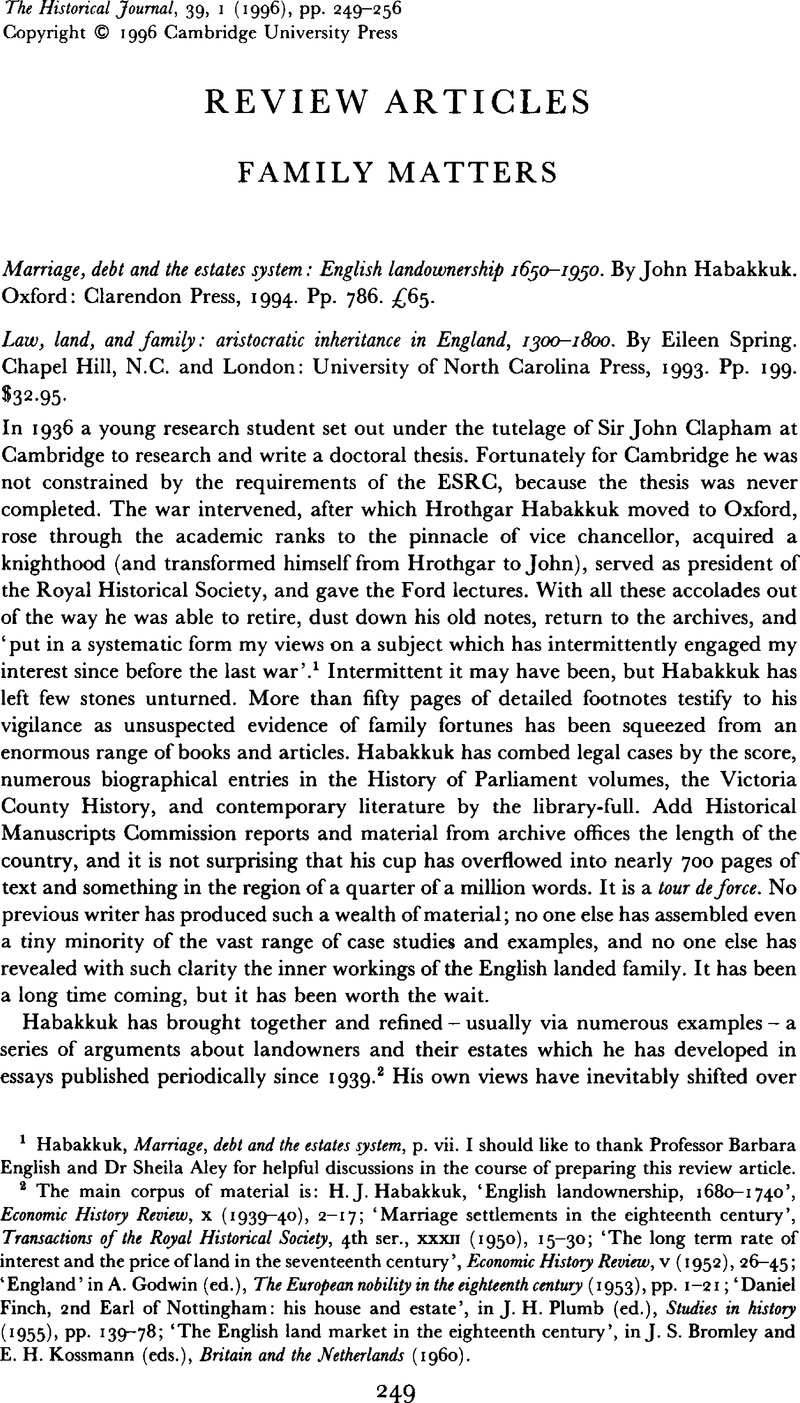Article contents
Family matters
Published online by Cambridge University Press: 11 February 2009
Abstract

- Type
- Review Articles
- Information
- Copyright
- Copyright © Cambridge University Press 1996
References
1 Habakkuk, , Marriage, debt and the estates system, p. viiGoogle Scholar. I should like to thank Professor Barbara English and Dr Sheila Aley for helpful discussions in the course of preparing this review article.
2 The main corpus of material is: Habakkuk, H. J., ‘English landownership, 1680–1740’, Economic History Review, X (1939–1940), 2–17Google Scholar; ‘Marriage settlements in the eighteenth century’, Transactions of the Royal Historical Society, 4th ser., XXXII (1950), 15–30Google Scholar; ‘The long term rate of interest and the price of land in the seventeenth century’, Economic History Review, V (1952), 26–45Google Scholar; ‘England’ in Godwin, A. (ed.), The European nobility in the eighteenth century (1953), pp. 1–21Google Scholar; ‘Daniel Finch, 2nd Earl of Nottingham: his house and estate’, in Plumb, J. H. (ed.), Studies in history (1955), pp. 139–78Google Scholar; ‘The English land market in the eighteenth century’, in Bromley, J. S. and Kossmann, E. H. (eds.), Britain and the Netherlands (1960).Google Scholar
3 SirHabakkuk, John, ‘The land settlement and the Restoration of Charles II’, Transactions of the Royal Historical Society, 5th ser., XXVIII (1978), 201–22CrossRefGoogle Scholar; ‘The rise and fall of English landed families, 1600–1800’, TRHS, 5th ser., XXIX (1979), 187–207Google Scholar; ‘The rise and fall of English landed families, 1600–1800: II’, TRHS, 5th ser., XXX (1980), 198–221Google Scholar; ‘The rise and fall of English landed families, 1600–1800: III. Did the gentry rise?’, TRHS, 5th ser., XXXI (1981), 195–217.Google Scholar
4 Habakkuk, , Marriage, debt and the estates system, p. 29Google Scholar; Spring, , Law, land and family, p. 129.Google Scholar
5 Habakkuk, , Marriage, debt and the estates system, p. 136.Google Scholar
6 Bonfield, L., ‘Marriage settlements and the “rise of great estates”: the demographic aspect’, Economic History Review, XXXII (1979), 483–93CrossRefGoogle Scholar; idem, ‘Marriage settlements and the “rise of great estates”’, Economic History Review, XXXIII (1980), 559–63Google Scholar; idem, ‘Marriage, property and the “affective family”’, Law and History Review, 1 (1983), 297–312Google Scholar; idem, Marriage settlements 1601–1740 (Cambridge, 1983)Google Scholar; idem, ‘“Affective families”, “open elites” and strict family settlement in early modern England’, Economic History Review, XXXIX (1986), 341–54Google Scholar; idem, ‘Strict settlement and the family: a differing view’, Economic History Review, XLI (1988), 461–6Google Scholar; Barbara, English and John, Saville, ‘Family settlement and the “rise of the great estates”’, Economic History Review, XXXIII (1980), 556–8Google Scholar; idem, Strict settlement: a guide for historians (Hull, 1983)Google Scholar; Eileen, Spring, ‘The family, strict settlement and historians’, Canadian Journal of History, XVII (1983), 379–98Google Scholar; idem, ‘Law and the theory of the affective family’, Albion, XVI (1984), 1–20Google Scholar; idem, ‘The strict settlement: its role in family history’, Economic History Review, XLI (1988), 454–60Google Scholar; idem, Law, land and family.
7 Spring, , Law, land and family, p. 144.Google Scholar
8 Habakkuk, , Marriage, debt and the estates system, p. 221.Google Scholar
9 Spring, , Law, land and family, p. 168Google Scholar; Thomas, D. M., ‘The social origins of marriage partners in the British peerage in the eighteenth and nineteenth centuries’, Population Studies, XXVI (1972).Google Scholar
10 Spring, , Law, land and family, p. 177.Google Scholar
11 Habakkuk, , Marriage, debt and the estates system, p. 277.Google Scholar
12 Ibid. p. 343.
13 Thompson, F. M. L., ‘Life after death: how successful nineteenth-century businessmen disposed of their fortunes’, Economic History Review, XLIII (1990), 40–61CrossRefGoogle Scholar; idem, ‘Stitching it together again’, Economic History Review, XLV (1992), 362–75Google Scholar; idem, ‘Business and landed elites in the nineteenth century’Google Scholar, in Thompson, F. M. L., Landowners, capitalists and entrepreneurs (Oxford, 1994), pp. 139–70Google Scholar; Rubinstein, W. D., ‘British millionaires, 1809–1949’, Bulletin of the Institute of Historical Research, XLVIII (1974), 202–23Google Scholar; idem, ‘New men of wealth and the purchase of land in nineteenth-century Britain’, Past and Present, XCII (1981), 125–47Google Scholar; idem, Men of property (1981)Google Scholar; idem, ‘Cutting up rich: a reply to F. M. L. Thompson’, Economic History Review, XLV (1992), 350–61.Google Scholar
14 Habakkuk, , Marriage, debt and the estates system, p. 536.Google Scholar
15 Ibid. p. 477.
16 Ibid. p. 620.
17 Ibid. p. 529.
18 Clay, C., ‘The price of freehold land in the later seventeenth and eighteenth centuries’, Economic History Review, XXVII (1974), 173–89.CrossRefGoogle Scholar
19 Barbara, English, The great landowners of East Yorkshire 1530–1910 (1990), p. 70.Google Scholar
20 Thompson, F. M. L., English landed society in the nineteenth century (1963)Google Scholar; David, Cannadine, The decline and fall of the British aristocracy (Yale, 1990).Google Scholar
21 Habakkuk, , Marriage, debt and the estates system, p. 414.Google Scholar
22 Ibid. p. 221.
23 Beckett, J. V., The rise and fall of the Grenvilles: dukes of Buckingham and Chandos, 1710–1921 (Manchester, 1994), pp. 67–8, 102–4Google Scholar; ‘Love and marriage among the English aristocracy: the Buckingham-Chandos alliance of 1796’, Records of Buckinghamshire, XXXIV (1992) [1994], 101–6Google Scholar; Marchand, L., Byron's letters and journals, IV (1975), 179, 202, 218.Google Scholar
- 1
- Cited by




